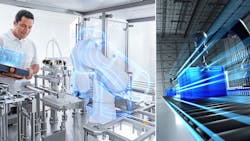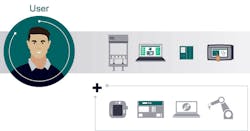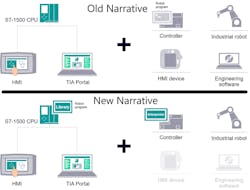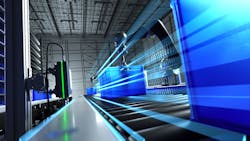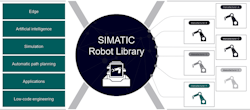Robots can Talk the Same Language
Driven by technological innovations, increasing applications, falling prices and greater adoption of factory automation, the use of robots is ballooning globally. From just 2013 to 2017, the number of annual industrial robot installations more than doubled in the combined American, Asian, Australian and European markets.
The rise of robots is streamlining many corners of factory automation, ranging from automotive to pharmaceutical to electronics manufacturing, among many others. And like other innovations in manufacturing, the increasing utilization of robots comes with a set of challenges.
While robots often operate in concert with other machine automation equipment, proper configuration can be complicated utilizing available programmers in the best circumstances, and impossible without the assistance of specialists in the worst cases.
Modern robot libraries within integrated automation software—and artificial intelligence (AI)—improve on this situation, making cross-manufacturer robot integration more readily available to a broader base of automation engineers.
Compatibility Issues
In many factories where robots are used, complex moves are configured and programmed within dedicated robot controllers. These controllers use inputs and outputs (I/O) for data exchange with PLCs and other automation components. This separation of controllers presents challenges for synchronous operation among robots and other machine equipment, especially among a diverse group of manufacturers’ robots, each with a different robot controller.
Each robot controller typically operates with unique software I/O structures, creating the requirement for a central PLC programmer to pair a different structure of code with each manufacturers’ controller among otherwise similar robots. The programmer must also ensure correct code usage in each of the various robot controllers, according to the rules of manufacturer-specific software and hardware.
Additionally, there are often robot HMIs to configure. With so many configuration environments—each typically requiring specialized knowledge of its particular programming characteristics and language—the required engineering and commissioning efforts, along with propensity for errors, are high (Fig. 1).
Service and maintenance also are complicated, particularly with many components to troubleshoot when issues arise.
Using Universal Robot Libraries
A new narrative in robot configuration and programming is on the rise, more closely integrating multi-axis robot control with other machine automation PLC code, driven by robot libraries provided with integrated automation software suites. These libraries—which provide the means to drive robots entirely in a PLC program—are empowering engineers and tech experts to program robots on their own, while reducing reliance on expensive specialists.
By bringing robot control within PLC code, automation engineers can program robots without the need to understand the intricacies of robot control language. The robot controller remains, acting as an interpreter of PLC code blocks, but interpretation takes place intelligently behind the scenes of the PLC-commanded moves (Fig. 2).
This enables easy integration of robots with other machine automation components using the same and familiar PLC programming software to control multiple manufacturers’ robots in a single subroutine, making time-sensitive robot interactions much easier to implement. In a typical deployment, there is no need to touch anything in the robot controllers.
While this functionality is especially useful for end-users, machine builders also benefit by increasing their ability to standardize automation programming. For end-users and machine builders alike, this functionality provides the ability to use the right robot for the desired job, with nearly identical programming and operational interfaces, regardless of the robot manufacturer.
These robot libraries also include standardized HMI faceplates, maintaining the same operational procedures, look and feel among multiple manufacturers. Within a robot faceplate on the primary machine HMI, programmed using the development software environment, engineers can place robots in jog mode to move them to defined positions. They can also teach robots positions and path points using built-in toolsets.
For new robots or paths, entire move trajectories are configurable in the graphical HMI faceplates, with the configured paths available for consumption and direct use in the PLC program. These universal HMI faceplates are ready-to-use in modern robot libraries, without any programming required—just relatively simple configuration.
The libraries serve as bridges to robotics, eliminating the need to change programming procedures or practices when switching among robot types or manufacturers. Some advanced systems even support simulation and AI-driven path planning, and the central location for all programming within a PLC makes edge computing with robots more achievable.
Robotic AI enhancements
AI is further increasing the effectiveness of robots on the plant floor, with intelligent spatial assessment and smart object recognition automatically enabling robots to perform many tasks without the need for complex customized movement algorithms. This helps production lines scale up with limited programming effort required, and it empowers manufacturers to increase production while decreasing lead time.
Robots can work in tandem with visual analysis AI to verify quality standards are met, and to improve their own movement intelligence over time. Robot AI application examples include:
- Robotic arms with mounted cameras verifying products are free of defects.
- Autonomous guided vehicles in warehouses calculating and learning the most efficient routes for material handling.
- Self-driving cars identifying and avoiding road hazards and obstacles.
- Picking and packing robots optimizing product placement orientation (Fig. 3).
Many robots still require operators or programmers to provide explicit instructions, but as these examples show, AI is becoming more prevalent. As this trend continues, robots will continue to carry out difficult, dangerous or demanding tasks otherwise executed by humans, freeing up skilled personnel to focus on innovative process improvements.
Identifying Results
A pharmaceutical manufacturer reduced programming and development time by about 30% by deploying the Siemens SIMATIC Robot Integrator software for use with its new and existing filling and sealing robots. Prior to the upgrade, engineers relayed messages for removing and placing hygienic labels between a robot controller and the PLC, which was driving other automated components on the line.
By deploying the Robot Integrator software, the manufacturer consolidated control to the central PLC, eliminating the need to write code in multiple robot controllers. This significantly reduced the programming learning curve because robot library code within the Siemens TIA Portal integrated automation suite is identical from robot manufacturer to manufacturer. Additionally, the robot HMI faceplates now provide the pharmaceutical manufacturer with the ability to quickly modify its recipes for pivoting between batches when required.
Save Time, Increase Efficiency
Robot integration libraries and advances in AI are increasing the value of robots on the plant floor by simplifying configuration, programming and maintenance. In some software environments, simulation and digital twins are available to help programmers tweak their code for more accurate robot moves prior to field deployment.
These capabilities provide automation engineers with more time to spend stringing together series of robot paths to get a job done—the time gained by eliminating the need to define the mechanics of each move, as well as data exchange between the PLC and robot controller. These capabilities also do away with custom robot software configuration and programming, making robot programming accessible to a wider base of engineers, regardless of the robot type or manufacturer (Fig. 4).
As a result, implementers are reducing project development time and costs, and benefitting from increased machine efficiency and manufacturing profitability.
Colm Gavin is the portfolio development manager for Siemens Digital Industries Software, responsible for the promotion of digitalization topics for machine and line builders in the United States.
